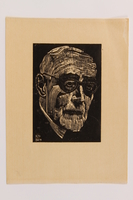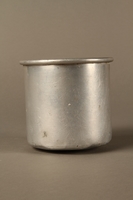Overview
- Description
- Documents, photographs, and a personal narrative regarding the Holocaust experiences of Aizik Eisen and his two grandaughters Julia and Tola Weinstock in Lwów, Poland [Lviv, Ukraine] and the assistance their family received from Lusia Nowicka, a non-Jewish Polish woman who hid them. Included is a post-war manuscript written by Aizik about his Holocaust experiences. The manuscript is in Yiddish, and includes an English translation. Documents include Aizik’s former concentration inmate identification card, his United States Declaration of Intention form, and naturalization certificate. Also included is a memorial document dedicated to family lost in the Holocaust, and a copyright registration form by Julie Keefer (née Weinstock) for Aizik’s personal narrative “The Grandfather of the Two Grandchildren in the time of the Murder of Hitler, 1941-1945.” Photographs include depictions of Aizik after the war in the Tyler/Wegscheid displaced persons camp with his granddaughters Julia and Tola and Luisa Nowicka, the woman who hid them. There is also one wartime photograph of Julia taken when she was a hidden child.
- Date
-
inclusive:
circa 1920-1987
- Credit Line
- United States Holocaust Memorial Museum Collection, Gift of Julie Klestadt Keefer
- Collection Creator
- Aizik Eisen
- Biography
-
Aizik Eisen (1893-1980, alternatively spelled Ajsik or Aisik) was born in 1893 in Lvov (Lwow), Poland (now L'viv, Ukraine). His wife’s name was Klara, and he had two children. He ran a wholesale fruit business, and other family members also lived in Lvov. His daughter Sala Rosenberg Weinstock was married to Chaim (Herman) Hersh. He worked as a tin smith and she was an opera singer and homemaker. Their daughter Jula Weinstock (later Julie Keefer) was born on April 19, 1941
At the time of Jula’s birth, the city was under the control of the Soviet Union which had invaded Poland in September 1939, a few weeks after Germany. Under the terms of the German-Soviet pact, Lvov became Soviet territory. In late June 1941, Germany invaded the Soviet Union, inciting pogroms by the local Ukrainian nationalists. Nearly 4000 Jews were massacred in early July, and another 2000 were murdered near the end of the month. In September, Jula and her family, and the other Jewish residents, were forcibly relocated to a ghetto closed in by a wooden fence. Aizik’s house was located in the area of the ghetto and Jula and her family moved into a barn behind it.
In November 1941, Aizik was picked up during an action and taken to Jaktorow labor camp where he was beaten regularly and forced to work in a limestone quarry. He eventually escaped, but in May 1942 was rearrested and sent to Janowska slave labor camp where he was forced to work hauling heavy stones. In November, Aizik escaped the camp and made his way to a village where a man gave him clothes, food, a shovel and told him it was safest in Borszczowice forest. Jula’s younger sister Tola was born in the spring of 1943. One day in June 1943, Aizik appeared at their home to help Jula and her family escape the ghetto. A man name Mr. Borecki had told Aizik that the ghetto was to be burned and he determined to save his family. He took them to the forest where he had built a bunker with about thirty other Jewish escapees.
Soon after they arrived, Aizik decided that Jula and her sister Tola had to be placed in hiding elsewhere because their crying was endangering the others. In December 1943, he arranged for Jula and Tola to live in Lvov with a former neighbor and family friend, Lucia Nowicka. Her husband had disappeared in 1939 and she lived with and worked for a Catholic family, the Swierczynski’s, whose home was next to that of the German governor of Lvov District. Aizik assumed the identity of Lucia’s husband, and Jula and Tola were introduced as Lucia’s nieces. Aizik continued to spend time with the group in the forest. One day he returned to Lvov to find that the Gestapo had arrested Lucia. Aizik found a hiding place for Tola in a Catholic children’s home under the name Antonina Nowicka. The Swierczynski family was able to get Lucia released. In April 1944, while Aizik was visiting the girls in Lvov, the Germans discovered the forest bunker and killed everyone inside. Around this time, Soviet troops were advancing on the region and Lvov was under frequent bombardment. After one explosion, the Germans evacuated the children’s home where Tola was hidden. Aizik and Jula were never able to locate Tola after that move.
In June 1944, the Red Army liberated the region. The war ended when Germany surrendered on May 7, 1945. Aizik, Lucia, and Jula lived in displaced persons camps in Poland and Austria, including Wegscheid Displaced Persons Camp (Camp Taylor) in Linz, Austria. Aizik heard that young orphans received preferential treatment for US entry visas. He decided to send Jula to America, and in 1948, Jula, then 7, left alone for the United States. Aizik hoped to join her there. Jula, now called Julie, was placed in a series of orphanages. She endured taunting due to her German accent and was sometimes called a Nazi. She was sent by The Joint Distribution Committee to the Bellefaire Jewish Children's Orphanage in Cleveland, OH. After seven years in the US, Julie was adopted by Fred and Thea Klestadt, Jewish immigrants who had arrived from Dusseldorf, Germany, in 1937. Aizik and Lucia married and in March 1950 arrived in the US, and settled in New Jersey. Julie attended Oberlin College, and became a French teacher. She also earned degrees in psychology, special education, and administration. Julie and her husband Larry have two children and live in Washington DC.
Physical Details
- Genre/Form
- Photographs. Personal narratives.
- Extent
-
1 box
- System of Arrangement
- The collection is arranged as a single series.
Rights & Restrictions
- Conditions on Access
- There are no known restrictions on access to this material.
- Conditions on Use
- Material(s) in this collection may be protected by copyright and/or related rights. You do not require further permission from the Museum to use this material. The user is solely responsible for making a determination as to if and how the material may be used.
Keywords & Subjects
- Topical Term
- Displaced persons camps. Hidden chidren (Holocaust)
- Personal Name
- Eisen, Aizik, 1893-1980. Keefer, Julie, 1941-
Administrative Notes
- Holder of Originals
-
United States Holocaust Memorial Museum
- Legal Status
- Permanent Collection
- Provenance
- The collection was donated to the United States Holocaust Memorial by Julie Keefer in 2012.
- Record last modified:
- 2024-07-11 07:32:54
- This page:
- https://collections.ushmm.org/search/catalog/irn47415
Additional Resources
Download & Licensing
In-Person Research
- Available for Research
- Plan a Research Visit
-
Request in Shapell Center Reading Room
Bowie, MD
Contact Us
Also in Julie Keefer family collection
The collection consists of a tin cup, documents, a manuscript, and photographs relating to the experiences of Aisik Eisen and his granddaughters Tola and Jula (later Julie Keefer) during the Holocaust in the ghetto and in hiding with the assistance of Lucia Nowicka, as well as a hat and table runner brought by Thea Klestadt from Dusseldorf, Germany, to the United States in 1938.

Woodcut portrait of Leo Baeck owned by a Jewish Polish girl
Object
Woodcut portrait of Leo Baeck, owned by Julie Keefer, a Jewish Polish girl who was in hiding during the Holocaust with her grandfather. Baeck was a Rabbi and intellectual theologian who emerged as an important symbolic and political leader of German Jewry before and during World War II. Baeck helped other Jews emigrate from Germany and fought for Jewish rights. In 1943 he was deported to Theresienstadt (Terezin) ghetto labor camp, where he gave lectures on philosophy and religion and became a leader among the camp’s Jews. In June 1941, when Julie was two months old, her hometown, Lvov, Poland (now Lviv, Ukraine) was occupied by German troops. In July several thousand Jews were massacred in pogroms. In November, Julie and her family were forced into Lvov ghetto and her grandfather, Aizik was taken to Jaktorow labor camp. In late 1943, Aizik rescued Julie and her family from the ghetto and they hid in a forest bunker. He decided Julie and her 5 month old sister Tola had to hide elsewhere as their crying made it dangerous for the others. In December he arranged for himself Tola and Julie to live with Lucia Nowicka who worked for a Catholic family. Aizik impersonated her husband and the two girls were introduced as nieces. When Lucia was briefly arrested, Aizik hid Tola in a Catholic children's home. During bombing in late spring 1944, the home was evacuated and he and Julie never saw Tola again. The bunker was discovered by the Germans and everyone was murdered. Lvov was liberated in June 1944 and the war ended in May 1945. Aizik, Julie, and Lucia lived in displaced persons camps. Aizik was able to get a US entry visa for Julie, and in 1948 Julie was sent to America where she lived in orphanages. Aizik and Lucia married and immigrated to the US in 1950. In 1955 Julie was adopted by Fred and Thea Klestadt, Jewish immigrants who had arrived from Dusseldorf, Germany, in 1937

Tin mug issued to a Jewish girl and her family at a displaced persons camp
Object
Tin mug issued to Julie (Jula) Weinstock, 5, her grandfather Aizik Eisen, and rescuer Lucia Nowicka in Wegscheid displaced persons camp, known as Camp Tyler, in Linz, Austria in 1946. In June 1941, when Julie was two months old, her hometown, Lvov, Poland (now Lviv, Ukraine) was occupied by German troops during their invasion of the Soviet Union. In July several thousand Jews were massacred in pogroms by local Ukrainians. In November, Jula and her family were forced into the Lvov ghetto and her grandfather, Aizik was taken to Jaktorow labor camp. Aizik escaped and in late 1943, he rescued Jula and her family from the ghetto and they hid in a forest bunker. He decided Jula and her 5 month old sister Tola had to hide elsewhere as their crying made it dangerous for the others. In December he arranged for himself, Tola, and Jula to live with Lucia Nowicka, who worked for a Catholic family. Aizik impersonated her husband and the two girls were introduced as nieces. When Lucia was briefly arrested, Aizik hid Tola in a Catholic children's home. During bombing in late spring 1944, the home was evacuated and he and Jula never saw Tola again. The bunker where Jula’s family was hiding was discovered by the Germans and everyone inside was murdered. Lvov was liberated in June 1944, and the war ended in May 1945. Aizik, Jula, and Lucia lived in several displaced persons camps. Aizik learned that young orphans could get United States entry visas and was able to get one for Jula. In 1948 Jula was sent to America where she changed her name to Julie and lived in orphanages. Aizik and Lucia married and immigrated to the US in 1950. In 1955 Julie was adopted by Fred and Thea Klestadt, Jewish immigrants who had arrived from Dusseldorf, Germany, in 1937



